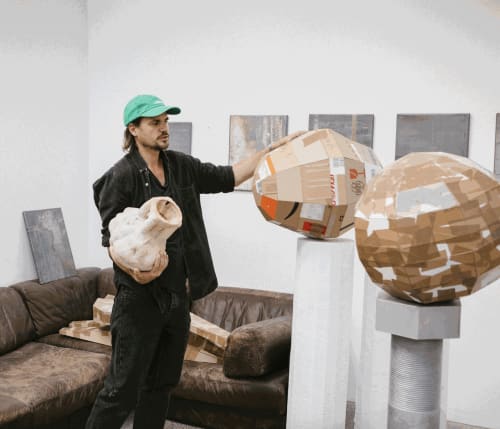Michael Sailstorfer’s artistic practice is shaped by an approach that questions the fragile balances of contemporary society and the threat of the depletion of limited resources. By removing natural, industrial, or random materials from their original contexts, he transforms these elements into formally rigorous sculptures with redefined meanings. The artist’s interest in biological and mechanical processes expands the traditional questions of form and function in sculpture, incorporating social, political, and economic dimensions to critically interpret the dynamics of contemporary culture. Sailstorfer’s works, through the relationship between material and context, involve familiar objects in a process of aesthetic and intellectual re-evaluation.
Known for his site-specific interventions, Michael Sailstorfer challenges traditional sculptural principles with his works, aiming to endow objects with new meanings and functions. Many of Sailstorfer’s works are based on revealing the physical elements of an object, breaking it down into parts. From car tires to popcorn machines or trees, Sailstorfer reinterprets everyday objects through poetic and often absurd interventions. The familiar objects he uses systematically detach from their original functions and acquire alternative meanings in different contexts. Michael Sailstorfer, transcending the boundaries of physicality, produces experimental works that include sensory elements such as smell, sound, and light. While known for his sculpture and installation practice, he also works across different disciplines, including painting, performance, photography, and film.
Born in 1979 in Velden, Germany, Michael Sailstorfer completed his art education at the Academy of Fine Arts in Munich before continuing his graduate studies at Goldsmiths University of London, graduating in 2004.
Sailstorfer’s works are part of the collections of numerous prestigious art institutions, including Centre Pompidou (France), Fondazione Morra Greco (Italy), Jerry Speyer (USA), Leopold Hoesch Museum (Germany), Mariano Pichler Collection (Italy), MARTa Herford (Germany), MUSEION (Italy), Museum Kurhaus Kleve (Germany), Paolo Kind (UK), Sammlung Boros (Germany), Sammlung Goetz (Germany), Städel Museum (Germany), and Walker Art Center (USA).
Michael Sailstorfer lives and works in Berlin.
